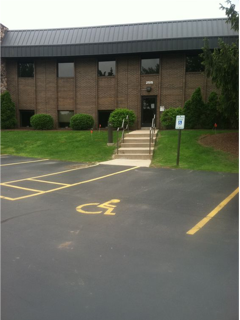The Non-Ramp
Last week I outlined several ideas for up-and-coming blog post. This is the first one on Accessibility and getting myself back on track to writing the blog. Texas at the turn of the millennium opened up their Registered Accessibility program to non-government employees of TDLR. At this point the ADA and Texas Accessibly Standards were 8 & 6 years old respectively. It took me a couple of years, but in 2004, I decided to go to the Texas Accessibility Academy and get registered.
 Fast forward several years and I still dig into the ADA. Since then, I’ve done a couple of presentations on the subject. These started off as live presentations. Then I started doing them a couple of years ago for CSINext when virtual presentations were fresh and new. This past September I did my first ON-Demand presentation for CONSTRUCT 2020. It is a very different experience to talk only to a web-cam. There is a lot of content at Virtual CONSTRUCT and with the end of the year just around the corner, it is a great way to capture a few of those missing CEU’s. https://gateway.on24.com/wcc/eh/2566093/construct-show-virtual
Fast forward several years and I still dig into the ADA. Since then, I’ve done a couple of presentations on the subject. These started off as live presentations. Then I started doing them a couple of years ago for CSINext when virtual presentations were fresh and new. This past September I did my first ON-Demand presentation for CONSTRUCT 2020. It is a very different experience to talk only to a web-cam. There is a lot of content at Virtual CONSTRUCT and with the end of the year just around the corner, it is a great way to capture a few of those missing CEU’s. https://gateway.on24.com/wcc/eh/2566093/construct-show-virtual
Enough with the history and sales pitch and back to the ramp. I really touched on this because it is the lightest part of my presentations to date, yet seems to be requested every time when I do them. I’m just not sure I could fill an hour or keep everyone’s attention for an hour on a ramp presentation. So, I thought I would break it down when a Ramp is not a Ramp.
First think about the accessible route. This is any pathway Floor or Ground Surface to get from point A to point B. ADA notes that these shall be stable, firm and slip resistance and no elevation changes greater than ¼” (exception, you can have ½” high carpet). This change can't exceed ½” otherwise it becomes a ramp, with one exception, the slope area can be 1:48 (or 2%). What the ADA is noting here is the clear area (maneuvering for doors, clear floor areas, etc.) or pathway for a route shall not exceed this 1:48.
After the pathway exceeds 1:48 then it becomes a ramp. Ramps have limits too. You can’t exceed 1:12 (8.3%), so a 10% slope is beyond the scope of ramp. This range is basically 1:47 to 1:12, keep in mind that ramps are not required to be exactly 1:12, another misconception. These slopes are only for the path of travel, the cross slope of a ramp can’t exceed 1:48. The length of a ramp is determined by a maximum of 30” rise and the slope. If your ramp is 1:12, then the length cannot exceed 30'. At each end of a ramp, you will need a level landing and as wide as the ramp. The minimum clear width of a ramp is 36”. However, not all ramps are ramps.
Ramps have requirements for handrails. When the vertical change is 6” (or less) then it moves into a special category of “Curb Ramp”. This is why you don’t see handrails at sidewalks crossing driveways or at parking spaces. Other than the handrail requirement, the curb ramp must meet the requirements of a ramp and the then there is the flares on the sides. The final debate on curb ramps is when do you have to have detectable domes. That depends.
 In Texas and the pure ADA, all curb ramps that cross public drives must have detectable domes (24”, full width of the ramp). But parking spaces, don’t require this. Detectable domes are to assist the blind that a hazardous area is about to entered (ie traffic). But wheelchairs and those on crutches finds the domes difficult to navigate. However, in California’s Title 24, these domes are required on all curb ramps, just as there are required by The Department of Transportation’s ADA standards.
In Texas and the pure ADA, all curb ramps that cross public drives must have detectable domes (24”, full width of the ramp). But parking spaces, don’t require this. Detectable domes are to assist the blind that a hazardous area is about to entered (ie traffic). But wheelchairs and those on crutches finds the domes difficult to navigate. However, in California’s Title 24, these domes are required on all curb ramps, just as there are required by The Department of Transportation’s ADA standards.
I know this is a lot of technical information in a short article. I probably missed something in trying to summarize the ramp. Once you start to peel back the onion, any element in ADA can become overwhelming, just take the "eating an elephant" approach. One bite at time and as we say at the TAS academy, “if supplied, it must comply”. This is always the best rule when to apply the ADA Standards to your project.
…and now for something completely different.
In their lifetime an average person would walk as much as circumferencing the world five times.
When you subscribe to the blog, we will send you an e-mail when there are new updates on the site so you wouldn't miss them.






